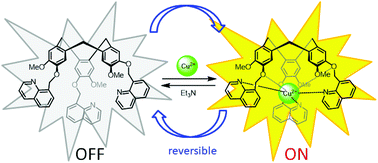A C3-substituted cyclotriveratrylene derivative with 8-quinolinyl groups as a fluorescence-enhanced probe for the sensing of Cu2+ ions†
Abstract
C 3-Substituted cyclotriveratrylene (CTV) derivatives were considered suitable candidates for recognition compounds due to their unique structures. In this study, a C3-substituted CTV derivative with three fluorogenic 8-quinolinyl groups (1) was designed and prepared as a fluorescent probe. The synthesized CTV derivative 1 exhibited a selective response of fluorescence enhancement toward Cu2+ ions among the examined cations. The sensing ability of CTV derivative 1 toward Cu2+ ions was superior to that of the previously reported C3-substituted CTV derivative with three 2-quinolinyl groups (2). It is, thus, suggested that the CTV structure plays an important role in selective sensing ability toward Cu2+ ions since the mono-quinoline compound 5 showed fluorescence properties toward the Cr3+, Fe2+ and Fe3+ ions in addition to Cu2+ ions. In other words, the high Cu2+ ion-selectivity of CTV derivative 1 was demonstrated even in the presence of other co-existing examined cations. Moreover, it was found that CTV derivative 1 could work as a reversible fluorescence-enhanced probe toward Cu2+ ions by the simple addition of Et3N.



 Please wait while we load your content...
Please wait while we load your content...